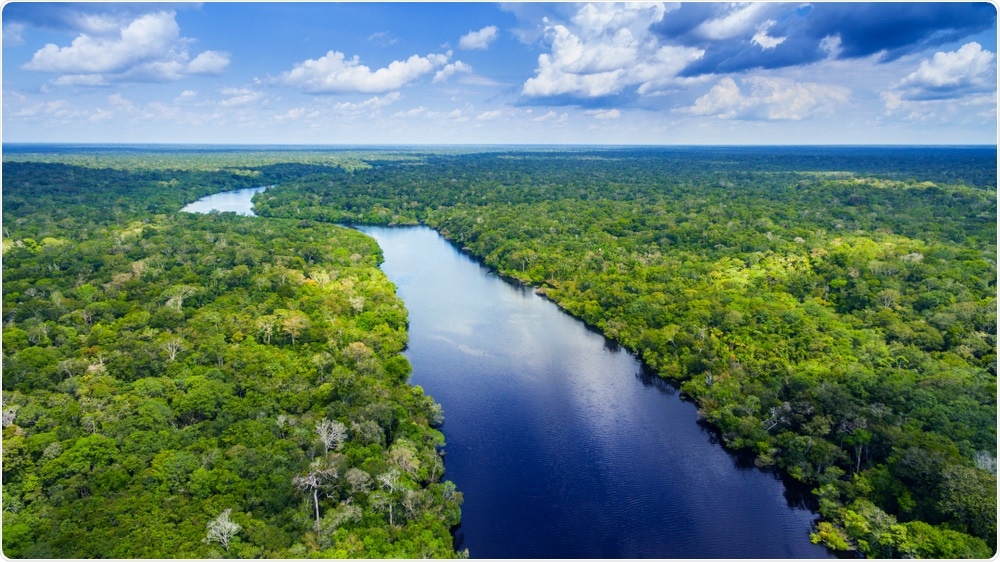A larger part of the Amazon rainforest is at risk of crossing a tipping point where it could become a savanna-type ecosystem than previously thought, according to new research. The research, based on computer models and data analysis, is published in the journal Nature Communications.

Image Credit: worldclassphoto/Shutterstock.com
Rainforests are very sensitive to changes that affect rainfall for extended periods. If rainfall drops below a certain threshold, areas may shift into a savanna state.
In around 40 percent of the Amazon, the rainfall is now at a level where the forest could exist in either state - rainforest or savanna, according to our findings,"
Arie Staal, Stockholm Resilience Centre and the Copernicus Institute of Utrecht University
The conclusions are concerning because parts of the Amazon region are currently receiving less rain than previously and this trend is expected to worsen as the region warms due to rising greenhouse gas emissions.
Staal and colleagues focused on the stability of tropical rainforests in the Americas, Africa, Asia and Oceania. With their approach they were able to explore how rainforests respond to changing rainfall.
"By using the latest available atmospheric data and teleconnection models, we were able to simulate the downwind effects of disappearance of forests for all tropical forests. By integrating these analyses over the entire tropics, the picture of the systematic stability of tropical forests emerged," says Obbe Tuinenburg, former assistant professor at the Copernicus Institute of Utrecht University and visiting scientist at the Stockholm Resilience Centre.
The team explored the resilience of tropical rainforests by looking at two questions: what if all the forests in the tropics disappeared, where would they grow back? And its inverse: what happens if rainforests covered the entire tropical region of Earth?
Such extreme scenarios could inform scientists about the resilience and stability of real tropical forests. They can also help us understand how forests will respond to the changing rainfall patterns as greenhouse gases in the atmosphere rise.
The researchers ran the simulations starting with no forests in the tropics across Africa, the Americas, Asia and Australia. They watched forests emerge over time in the models. This allowed them to explore the minimum forest cover for all regions.
Staal said, "The dynamics of tropical forests is interesting. As forests grow and spread across a region this affects rainfall - forests create their own rain because leaves give off water vapour and this falls as rain further downwind. Rainfall means fewer fires leading to even more forests. Our simulations capture this dynamic."
The team ran the models a second time, this time in a world where rainforests entirely covered the tropical regions of Earth. This is an unstable scenario because in many places there is not enough rainfall to sustain a rainforest. In many places the forests shrank back due to lack of moisture.
As forests shrink, we get less rainfall downwind and this causes drying leading to more fire and forest loss: a vicious cycle."
Finally the researchers explored what happens if emissions keep rising this century along a very high-emissions scenario used by the Intergovernmental Panel on Climate Change (IPCC).
Overall, the researchers found that as emissions grow, more parts of the Amazon lose their natural resilience, become unstable and more likely to dry out and switch to become a savanna-type ecosystem. They note that even the most resilient part of the rainforest shrinks in area. In other words, more of the rainforest is prone to crossing a tipping point as emissions of greenhouse gases reach very high levels.
"If we removed all the trees in the Amazon in a high-emissions scenario a much smaller area would grow back than would be the case in the current climate," says co-author Lan Wang-Erlandsson of the Stockholm Resilience Centre.
The researchers conclude that the smallest area that can sustain a rainforest in the Amazon contracts a substantial 66% in the high-emissions scenario.
In the Congo basin the team found that the forest remains at risk of changing state everywhere and will not grow back once gone, but that under a high emissions scenario part of the forest becomes less prone to crossing a tipping point. But Wang-Erlandsson adds 'This area where natural forest regrowth is possible remains relatively small."
We understand now that rainforests on all continents are very sensitive to global change and can rapidly lose their ability to adapt. Once gone, their recovery will take many decades to return to their original state. And given that rainforests host the majority of all global species, all this will be forever lost."
Ingo Fetzer, Stockholm Resilience Centre
The academics found that the minimal and maximal extents of the rainforests of Indonesia and Malaysia are relatively stable because their rainfall is more dependent on the ocean around them than on rainfall generated as a result of forest cover.
The study only explored the impacts of climate change on tropical forests. It did not assess the additional stress of deforestation in the tropics due to agricultural expansion and logging.